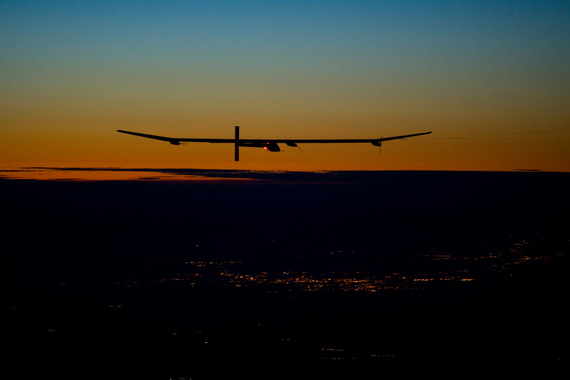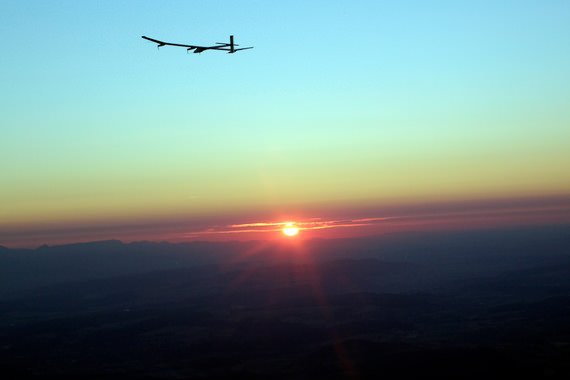[/caption]
After flying for over 26 straight hours, pilot André Borschberg landed the solar-powered Solar Impulse HB-SIA airplane to cheers and applause at the Payerne airbase in Switzerland, successfully completing the goal of flying the aircraft through the night. According to Bertrand Piccard, president of Solar Impulse, there was power to spare, with over three hours of energy remaining in the sun-gathering lithium batteries. “This is a highly symbolic moment: flying by night using solely solar power is a stunning manifestation of the potential that clean technologies offer today to reduce the dependency of our society on fossil fuels!” Piccard said. “We are on the verge of the perpetual flight.”
With an official flight time of 26 hours and 9 minutes, the lightweight carbon fiber plane reached a a maximum altitude of 8,700 m (28,543 ft), a top speed of 68 knots (ground speed), an average speed of 23 knots. The HB-SIA flew solely on solar power, gathering and storing it during the daylight hours, and using the energy to fly through the night.

“During the whole of the flight, I just sat there and watched the battery charge level rise and rise! Sitting in a plane producing more energy than it consumes is a fantastic feeling”, said Borschberg, CEO and co-founder of the Solar Impulse project.
The Solar Impulse HB-SIA has 12,000 solar cells built into its 64.3-meter (193-foot) wings, and is a prototype for an aircraft that the Solar Impulse team hope to fly around the world in a continuous flight in 2012.
Solar impulse weights 1,600 kg (3,500 lb), and is powered by four electric motors.
“Nothing can prevent us from another day and night, and the myth of perpetual flight,” a jubilant Piccard said at a press conference following the flight.
Update: Here’s a video from Solar Impulse, as the team waited for the sunrise:
Source: Solar Impulse, Solar Impulse webcast
Here’s an article about the biggest airplane.


Well, he had about 15 hours and 45 minutes of daylight to charge the batteries. That leaves 8h15 of night flight. So he had 3 hours of charge left? That means that he could fly through a 11h15 night on a full charge. Supposing that 12h45 is enough to fully charge the batteries, then he won’t make it through the night between the 10th of September through to the end of March. To if he wants to circumnavigate the Earth, he has to do it in summer. And stay in the same hemisphere of course. At Payerne’s latitude, at 23 knots, it would take about 28 days. He could do it, since he has a 5 months window of opportunity to do it with enough sunlight.
Good job Solar Impulse! I wonder if they fill the wings with Helium?
28 days flying solo humm. Rutans Voyager circumnavigated Earth in 9 days with 2 pilots. I wander why they had 2 pilots.
@ioresult: well, we should call it Summer Solar Powered Airplane for now 🙂 beyond southern polar circle, they have just a few hours of dim daylight these days, so we are miles away from making a plane capable of flying in that conditions.
@ Emilio
Rutans Voyager circumnavigated Earth in 9 days without stopping, so they needed the two pilots for shift work, I can’t remember the details but they were exhausted over the 9 days due to badly organized shifts. I guess they had no form of autopilot and Voyager was very hard to control, so may have needed a human presence anyway.
I’d be far more impressed with a solar powered blimp that can fly for years on Mars or (in the upper atmosphere of) Venus.
Personally I’d think that would be easier than a heavier-than-air craft, or a rover. I don’t understand why they aren’t sending blimps out to every planet or moon with a substantial atmosphere.
That’s impressive! A huge step ahead, even if it’s only a prototype. I wonder how soon a passengers plane would become reality…
@gopher65: “a solar powered blimp that can fly for years on Mars” Yeah yeah… I like! OR a cross/combo heavier than ‘air’ blimp ship with helium used to inflate aerodynamic wingforms? Weather being somewhat unknown or unpredictable on Mars, it would be good to have firm flight control and motive power and also be able to land and ‘hunker down’ during storms, say planetary dust storms?
Winds in Venus’ atmosphere may preclude the use of dirigibles there?
Because they don’t last long, so bad ROI?
That said, I believe there are ongoing work to make hot air (i.e. long-lasting) balloons. Dunno about the feasibility, cost, et cetera, but at a guess they would be a _major_ investment.
“I don’t understand why they aren’t sending blimps out to every planet or moon with a substantial atmosphere” Perhaps because there aren’t that many suitable candidates? Additionally, why make the investment in sending rather fragile airships when we can send robotic rovers for nearly the same cost?
Personally, I don’t see much scientific benefit in this type of craft.
This is a great, great achievement.
Battery tech will get better, the ruggedness of this fragile craft will improve but this is a great milestone.
And someday, we will have a road worthly solar car.
Wow! Just about as fast as a bicycle, except when I’m on a bicycle, I can take a rest stop whenever I feel like it and don’t need to wear a diaper or catheter.